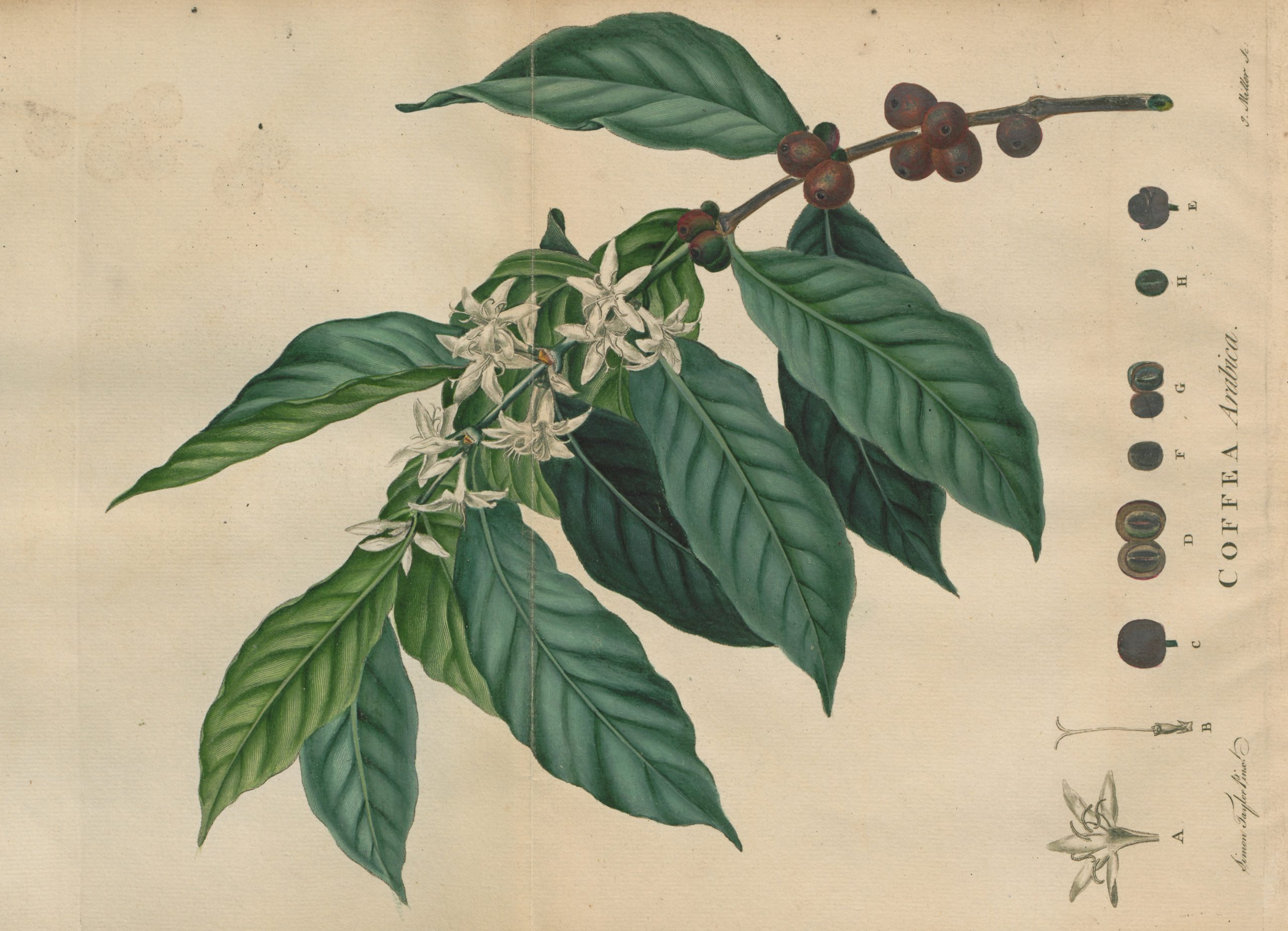
ジョン・エリス(John Ellis)『コーヒーの歴史的記述(An Historical Account of Coffee)』
ジョン・エリス(John Ellis, 1710年 - 1776年)は、イギリスの博物学者である。彼は晩年の1770年から1776年まで、ドミニカの王室調査官に任命された。
彼は1774年に『コーヒーの歴史的記述:版画と、その木の植物学的記載とともに:食習慣および商取引の記事として、その文化および使用に関連する雑記を加えて(An Historical Account of Coffee: With An Engraving, And Botanical Description Of The Tree: to which are added sundry papers relative to its culture and use, as an Article of Diet and of Commerce)』を出版した。
「科学の促進、国の優位性、そしてイギリスの繁栄(the promotion of science, national advantage, and the prosperity of the Island)」のために出版されたこの本では、コーヒーノキの花と果実の説明から始まり、同時代の様々な旅行記を引用しながら、コーヒーの歴史を紐解いている。
An historical account of coffee : with an engraving, and botanical description of the tree : to which are added sundry papers relative to its culture and use, as an Article of Diet and of Commerce:https://archive.org/details/2472012R.nlm.nih.gov/page/n11/mode/2up
An historical account of coffee: with an engraving, and botanical description of the tree : to which are added sundry papers relative to its culture and use, as an Article of Diet and of Commerce:https://collections.nlm.nih.gov/bookviewer?PID=nlm:nlmuid-2472012R-bk#page/12/mode/2up
An Historical Account of Coffee: With an Engraving, and Botanical Description of the Tree. To which are Added Sundry Papers Relative to Its Culture and Use, as an Article of Diet and Commerce:https://books.google.co.jp/books?id=kp1fAAAAcAAJ&printsec=frontcover&hl=ja#v=onepage&q&f=false
序文では、この本が彼の友人であるイギリスの医師、ジョン・フォザーギル(John Fothergill, 1712年 - 1780年)との関わりに依拠している旨が述べられている。フォザーギルは、イギリスでのコーヒーの使用を普及させ、西インド諸島でのコーヒー栽培を促進した人物である。
The Works of John Fothergill, M.D.:https://books.google.co.jp/books?id=pEcbAAAAYAAJ&printsec=frontcover&hl=ja#v=onepage&q=286&f=false
ジョン・エリス(John Ellis)『コーヒーの歴史的記述(An Historical Account of Coffee)』の抜粋
Schehabeddin Ben, an Arabian author of the ninth century of the Hegira, or fifteenth of the Christians, attributes to Gemaleddin, Mufti of Aden, a city of Arabia Felix, who was nearly his contemporary, the first introduction into that country, of drinking coffee. He tells us, that Gemaleddin, having occasion to travel into Persia, during his abode there saw some of his countrymen drinking coffee, which at that time he did not much attend to; but, on his return to Aden, finding himself indisposed, and remembering that he had seen his countrymen drinking coffee in Persia, in hopes of receiving some benefit from it, he determined to try it on himself; and, after making the experiment, not only recovered his health, but perceived other useful qualities in that liquor; such as relieving the head-ach, enlivening the spirits, and, without prejudice to the constitution, preventing drowsiness. This last quality he resolved to turn to the advantage of his profession; he took it himself, and recommended it to the Dervises, or religious Mahometans, to enable them to pass the night in prayer, and other exercises of their religion, with greater zeal and attention. The example and authority of the mufti gave reputation to coffee. Soon men of letters, and persons belonging to the law, adopted the use of it. These were followed by the tradesmen and artisans that were under the necessity of working in the night, and such as were obliged to travel late after sun-set. At length the custom became general in Aden; and it was not only drunk in the night by those who were desirous of being kept awake, but in the day for the sake of its other agreeable qualities.
John Ellis(1774)「An Historical Account of Coffee: With An Engraving, And Botanical Description Of The Tree」p.5-6
アデンのムフティ、ゲマレディン(Gemaleddin)が、アデンに最初にコーヒーを導入した人物として紹介されている。
Before this time coffee was scarce known in Persia, and very little used in Arabia, where the tree grew. But, according to Schehabeddin, it had been drunk in Æthiopia from time immemorial.
Coffee being thus received at Aden, where it has continued in use ever since without interruption, passed by degrees to many neighbouring towns; and not long after reached Mecca, where it was introduced, as at Aden, by the Dervises, and for the same purposes of religion.
The inhabitants of Mecca were at last so fond of this liquor, that, without regarding the intention of the religious, and other studious persons, they at length drank it publicly in coffee-houses, where they assembled in crowds to pass the time agreeably, making that the pretence. From hence the custom extended itself to many other towns of Arabia, particularly to Medina, and then to Grand Cairo in Egypt, where the dervises of Yemen, who lived in a district by themselves, drank coffee on the nights they intended to spend in devotion.
John Ellis(1774)「An Historical Account of Coffee: With An Engraving, And Botanical Description Of The Tree」p.6-7
アデンのムフティのように、メッカではダルヴィーシュによって、宗教目的でコーヒーが使用された。メッカでは、宗教者などに限定されず広く公衆に使用された。それ以来、この習慣はアラビアの他の多くの町、特にメディナ、そしてイエメンのダルヴィーシュが住んでいたエジプトのグランド・カイロに広がった。
Coffee continued its progress through Syria, and was received at Damascus and Aleppo without opposition; and in the year 1554, under the reign of Solyman, one hundred years after its introduction by the Mufti of Aden, became known to the inhabitants of Constantinople; when two private persons of the names of Schems and Hekin, the one coming from Damascus, and the other from Aleppo, opened coffee-houses in Constantinople, and sold Coffee publicly, in rooms fitted up in na elegant manner;
John Ellis(1774)「An Historical Account of Coffee: With An Engraving, And Botanical Description Of The Tree」p.7
コーヒーはシリアからダマスカスとアレッポへ広がり、ソリマンの治世下の1554年、一人はダマスカス、もう一人はアレッポからやってきたシェムス(Schems)とヘキン(Hekin)という名前の二人の人物が、コンスタンティノープルにコーヒー・ハウスを開いたことで、コンスタンティノープルの住民に知られるようになった。
It is not easy to determine at what time, or upon what occasion, the use of coffee passed from Constantinople to the western parts of Europe. It is, however, likely that the Venetians, upon account of the proximity of their dominions, and their great trade to the Levant, were the first acquainted with it; which appears from part of a letter wrote by Peter della Valle, a Venetian, in 1615, from Constantinople; in which he tells his friend, that, upon his return he should bring with some Coffee, which he believed was a thing unknown in his country.
John Ellis(1774)「An Historical Account of Coffee: With An Engraving, And Botanical Description Of The Tree」p.11
コンスタンティノープルからヨーロッパ西部にコーヒーがいつどのようにして広まったかは定かでない。ヴェネチアとレバントは領土が近く、交易が盛んだったことから、最初にコーヒーを知った可能性がある。ヴェネチア人のピーター・デラ・ヴァレ(Peter della Valle)(ピエトロ・デラ・ヴァレ(Pietro Della Valle))が、1615年にコンスタンティノープルから友人に送った手紙にコーヒーに関する記述がある。
The travels of Pietro della Valle in India : from the old English translation of 1664:https://archive.org/details/travelsofpietrod00dell/page/20/mode/2up
Mr. Garland tells us he was informed by M. de la Croix, the King's interpreter, that M. Thevenot, who had travelled through the East, at his return in 1657, brought with him to Paris some coffee for his own use, and often treated his friends with it.
John Ellis(1774)「An Historical Account of Coffee: With An Engraving, And Botanical Description Of The Tree」p.12
ガランは、王の通訳であるフランソワ・ペティ・ド・ラ・クロワ(François Pétis de la Croix)から、東方を旅し1657年に帰国したメルキゼデック・テヴェノ(Melchisédech Thévenot)が、自分用のコーヒーをパリに持って帰り、しばしば彼の友人に振る舞ったと知らされたと語っている。
It was known some years sooner at Marseilles; for, in 1644, some gentlemen who accompanied M. de la Haye to Constantinople, brought back with them on their return, not only some coffee, but the proper vessels and apparatus for making it. However, until 1660, coffee was drunk only by such as had been accustomed to it in the Levant, and their friends; but that year some bales were imported from Egypt, which gave a great number of persons an opportunity of trying it, and contributed very much to bringing it into general use; and in 1671, a coffee-house was opened at Marseilles in the neighbourhood of the Exchange, which succeeded extremely well;
John Ellis(1774)「An Historical Account of Coffee: With An Engraving, And Botanical Description Of The Tree」p.12
フランスでは、パリよりもマルセイユで数年先に知られていた。1644年に、ジャン・ド・ラ・ヘイ(Jean de La Haye)を連れ立った幾人かの紳士が、コーヒーだけでなくそれを作るための器や器具を持ち帰ったためだった。1671年に、取引所の近くにあるマルセイユにコーヒーハウスが開かれ、非常に成功した。
Before 1669, coffee had not been seen at Paris, except at M. Thevenot's, and some of his friends'; nor scarce heard of but from the account of travellers. In that year, Soliman Aga, ambassador from the Sultan Mahomet the Fourth. This must be looked upon as the true period of the introduction of Coffee into Paris. For that minister and his retinue brought a considerable quantity of coffee with them, which they presented to fo many persons of the court and city, that many became accustomed to drink it, with the addition of a little sugar;
John Ellis(1774)「An Historical Account of Coffee: With An Engraving, And Botanical Description Of The Tree」p.13
パリへのコーヒーの導入の真の時期は、ソリマン・アガ(Soliman Aga)の到来を待たなければならない。
It appears from Anderson's Chronological History of Commerce, it appears that the use of coffee was introduced into London some years earlier than into Paris. For in 1652 one Mr. Edwards, a Turkey merchant, brought home with him a Greek servant, whose name was Pasqua, who understood the roasting and making of coffee, till then unknown in England. This servant was the first who sold coffee, and kept a house for that purpose in George Yard Lombard Street.
John Ellis(1774)「An Historical Account of Coffee: With An Engraving, And Botanical Description Of The Tree」p.13-14
アンダーソンの商取引の年表から、コーヒーの使用はパリよりも数年早くロンドンに導入されたようである。 1652年、トルコの商人であるエドワーズが、パスクア(Pasqua)というギリシャ人の使用人を連れて帰った。彼はそれまでイギリスでは知られていなかったコーヒーの焙煎と製造を理解していた。 この使用人はコーヒーを売った最初の人であり、その目的のためにジョージ・ヤード・ロンバード・ストリートに家を構えていた。











